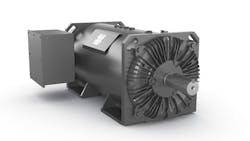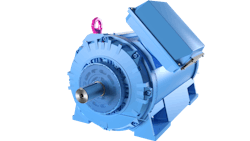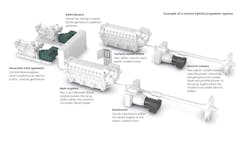OTC 2023: Water-cooled motors providing significant benefits offshore
By Ariana Hurtado, Editor and Director of Special Reports
HOUSTON — At OTC this week, ABB’s NEMA Motors Division is showcasing its water-cooled motors in both IEC and NEMA frames as well as severe duty motors, top-drive drill motors, ACS880 variable speed drives and ABB Ability Smart Sensors.
Bill E. Martin, senior development engineer with ABB, explained to Offshore how other motor products on the market have failed to meet the needs of the industry.
"The need for an alternative to air-cooled motors was first identified in the mining industry more than 50 years ago," he said. "A motor was needed that was capable and certified to operate in hazardous conditions. Water-cooled motors are capable of safely operating in Division II locations, which may contain dusts either electrically conductive or explosive in air. Most open, air-cooled motors cannot operate in Division II environments, and even totally enclosed, fan-cooled motors must meet strict requirements (such as IEEE 841 certification) to do so."
Martin said the evolution of current water-cooled motors is largely the result of the needs of the offshore, marine and mining segments, and that traditionally, open, air-cooled motors were used to power tools and equipment in those applications.
"Air-cooled motors, while reliable for open-air, lighter-duty applications, could not hold up in the rugged conditions common in offshore, marine and mining environments," he explained. "As the name implies, air-cooled motors require air flow to cool the machinery. This possesses several shortcomings. The first is that natural air flow often does not provide enough cooling action for the motors, so blowers are needed to augment the cooling. Blowers can be loud and require an additional power source. Water-cooled motors do not need a blower, and therefore run quieter."
Another challenge, Martin said, is that air-cooled motors, with or without blowers, pull in unfiltered air from the surrounding area, which often leads to debris and dirty air (onshore) or salt-laden air (offshore) coating the motor. This unclean air leads to corrosion and shortened motor life.
"Size is also a consideration since space is at a premium in offshore and marine environments," he added. "A water-cooled motor is inherently more power dense, meaning its design allows a smaller motor to provide greater power than a similarly sized air-cooled motor."
Water-cooled motors also are designed to offer improved life-cycle costs.
"Longer intervals between services and a longer service life are achieved, mainly because the bearings and windings are protected from the overheating that can occur in air-cooling systems," Martin said.
Capabilities and applications
The HydroCool XT motor is available in NEMA frame sizes 360, 400, 440 (and soon 5,800) from 60 hp to 1,250 hp (45 kW to 930 kW). With an induction rotor, it achieves a NEMA Premium efficiency (IE3) rating. The permanent magnet rotor version achieves IE5 levels of efficiency. Through ABB’s motor configurator, customers can get a partially or fully custom motor based on their inputs.
"Both motors are capable of direct-on-line operation (induction) or can be used with a variable speed drive for better control and even more efficiency (permanent magnet), Martin said.
Class I Division 2, IECEx and ATEX increased safety certifications are available, as are IP 55 or IP56 ingress protection options. Both configurations also include provisions for ABB Ability Smart Sensors for condition monitoring. ABB’s ACS880 is the preferred variable speed drive to operate the company’s NEMA and IEC water-cooled motors.
In addition, a 600-volt large-frame AC top-drive motor is available, designed specifically for onshore and offshore drilling applications.
"One major application solution that has delivered valuable benefits is diesel-electric propulsion," Martin said. "With this form of propulsion, a vessel’s diesel engine or engines are used to drive a generator to produce electricity. This electricity is used to power two critical components, the AC variable speed drive (VSD) and electric motor. The VSD allows the speed of the propulsion motors to be controlled from zero all the way up to their maximum rated operating speed, without any need for change in the running speed of the diesel engines driving the generators."
He continued, "As a result, the diesel engines can always run at a speed where they operate efficiently, and their emissions are minimized. This hybrid propulsion system combines traditional combustion engines with electric motor and generator power to optimize engine operation while reducing operational costs. In this type of system, water-cooled motors the power stored by the gensets in the power bank and provide power to the prop shafts when the vessel is run under electric power."
Case studies
ABB has been providing integrated propulsion and positioning for cruise ships and cargo vessels with its Azipod propulsion systems, and that technology is now being scaled to smaller vessels to support the offshore industry.
For offshore support vessels (OSVs) and platform supply vessels, ABB provides electric power, propulsion and automation solutions tailored for optimal efficiency, reliability and performance in demanding offshore conditions," Martin said. "ABB solutions for these applications are based on the company’s experience in electric power, propulsion and automation technology. OSV solutions pair electric or hybrid propulsion systems (powered by water-cooled electric motors) with ABB Ability Marine Pilot dynamic positioning system. ABB drives, switchboards, energy storage batteries and generators, and remote diagnostic systems tie everything together."
These integrated applications are new to offshore, so formal case studies have not yet been developed.
Future developments
The company is planning additional product development work, with aims to include more applications.
"The recent launch of the HydroCool XT water-cooled motor represents a great example of aligning product development with market needs," Martin said. "Prior to this offering, most ABB water-cooled motors were manufactured as custom products, based on specifications from customers—usually original equipment manufacturers who saw the benefits of using water-cooled motors in their systems sold to end users. HydroCool XT was developed using specific requests by customers who were looking for an 'off-she-shelf' solution for their applications."
Additionally, ABB is developing a new version of the HydroCool XT in a 5,800 NEMA frame. This new motor will create a slight overlap in offerings between smaller NEMA-framed motors and larger IEC-framed motors, but it will allow customers to select the frame dimensions most appropriate for their needs, whether those decisions are based on power requirements, geographical location or to match the existing configuration of their current systems.
FPSO electrical systems
Last month Sembcorp Marine subcontracted ABB to provide to the electrical system automation for the P-82 FPSO, under construction for the Petrobras-operated Búzios Field in the Santos Basin presalt offshore Brazil.
ABB will supply the topside and hullside electrical systems. The former will be installed in an eHouse, a prefabricated, modular substation designed to reduce costs, risk exposure and onsite work as all the components are wired, tested and commissioned before shipment to the fabrication yard.
For more information, visit ABB at OTC booth 1928.
05.02.2023
About the Author
Ariana Hurtado
Editor-in-Chief
With more than a decade of copy editing, project management and journalism experience, Ariana Hurtado is a seasoned managing editor born and raised in the energy capital of the world—Houston, Texas. She currently serves as editor-in-chief of Offshore, overseeing the editorial team, its content and the brand's growth from a digital perspective.
Utilizing her editorial expertise, she manages digital media for the Offshore team. She also helps create and oversee new special industry reports and revolutionizes existing supplements, while also contributing content to Offshore's magazine, newsletters and website as a copy editor and writer.
Prior to her current role, she served as Offshore's editor and director of special reports from April 2022 to December 2024. Before joining Offshore, she served as senior managing editor of publications with Hart Energy. Prior to her nearly nine years with Hart, she worked on the copy desk as a news editor at the Houston Chronicle.
She graduated magna cum laude with a bachelor's degree in journalism from the University of Houston.



